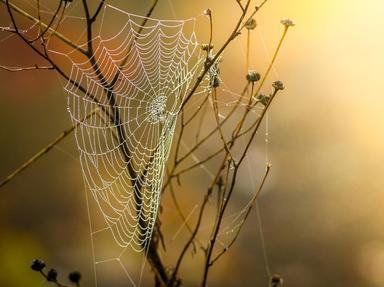Quiz Answer Key and Fun Facts
1. This nasty critter is the venomous brown recluse spider that is often found in closets, garages and cellars in parts of North America. By what alternative name is it also known?
2. This South American native is 'Scytodes globula', the best-known species of 'spitting spider'. Sometimes called "long-legged spider", it is the only predator of the common and highly dangerous Chilean recluse spider. What is this species commonly called?
3. Sometimes called a daddy-longlegs, this species of cellar spider is often a welcome sight as it is known to kill other spiders that are much more of a threat to humans. Their webs are often seen clinging to the ceilings of rooms, garages and cellars. By what other name, due to the shape of their cephalothorax (head and the thorax together) are they known?
4. Sometimes called a slater spider, the more common name for 'Dysdera crocata' comes from its exclusive food source. Originating in Europe but now found worldwide, they are usually found under logs in warm places. By what name are they best known?
5. Native to Central and Eastern Europe, 'Eresus cinnaberinus' make their home in underground cylindrical tubes roughly four inches in diameter. This spider's common name derives from the colouring on its opisthosoma (the rear part of its body). By what common name is it known?
6. This wonderful photograph makes this spider look like some evil invader from a sci-fi movie. In fact, this is a member of the 'Mimetus' genus found virtually everywhere on our own planet. This genus is part of which family of specialist spider-killing spiders?
7. Containing 32 recognized species distributed worldwide, the 'Latrodectus' genus contains many of the most venomous spiders. Sometimes called redbacks in Australia and button spiders in Africa, by what common name are they best known?
8. Species within the 'Phoneutria' genus are known in Portuguese as 'armadeiras' ("armed spiders"). Amongst them is the species named by 'Guinness World Records' since 2010 as the world's most venomous spider. What is the common name for spiders in this genus?
9. The pictured species is native to northern and central Europe. It is a member of the 'Sparassidae' family, also sometimes known as giant crab spiders. By what common name are this family of spiders known?
10. Native to Canada and the artic regions, 'Misumena vatia' is the largest and best known North American species of flower spider. Usually found hunting in goldenrods, they can be either white or yellow (depending on the colour of the flower where they are hunting). A member of the 'Thomisidae' super-family, what is the common name for these species?
Source: Author
EnglishJedi
This quiz was reviewed by FunTrivia editor
Tizzabelle before going online.
Any errors found in FunTrivia content are routinely corrected through our feedback system.

